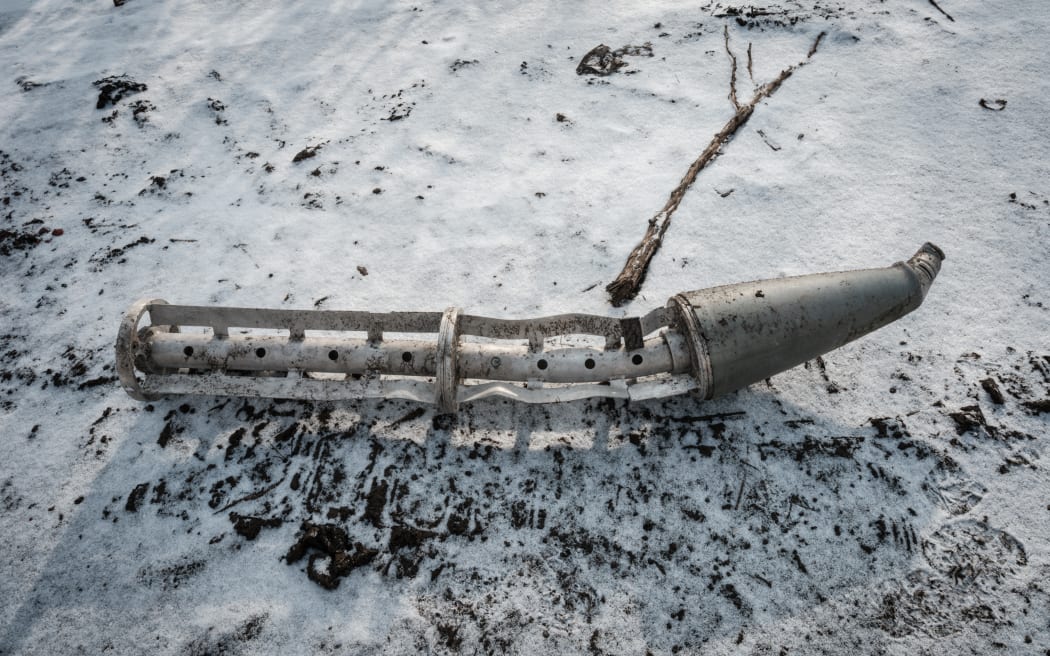There's been a chorus of outrage at plans by the US to send cluster bombs to the Ukraine – but the move is legal, even if it might not be morally defensible.

A casing of a cluster bomb rocket lays on the snow-covered ground in Zarichne on 6 February, 2023, amid the Russian invasion of Ukraine. Photo: AFP / Yasuyoshi Chiba
When the US announced it would send controversial cluster bombs to Ukraine, it caused a global outrage.
"The Ukrainians are running out of ammunition," President Joe Biden said in defence of the move.
But even some of his own Democratic colleagues criticised it.
"Cluster bombs should never be used, that's crossing the line," said congresswoman Barbara Lee.
Prime minister Chris Hipkins called them indiscriminate, causing potentially "huge damage to innocent people".
When a cluster munition is fired from a rocket or aircraft, it opens out in midair and releases smaller, sub-munitions. Depending on the type, one munition can release anything from two to 100 sub munitions.
"They scatter, they spread right out," says Auckland University associate law professor Treasa Dunworth, who specialises in disarmament law. "So it has a massive footprint."
They are also considered indiscriminate because of the high failure or "dud" rate, she says. That means that a high number of the submunitions do not detonate when they land.
"Because they fail to detonate they essentially lie in wait, so they become a land mine," says Dunworth.
"It means that long after the war you have this infestation of lethal weapons in the ground."
The Pentagon says the "dud" rate on the cluster munitions being sent to Ukraine is 2.35 percent. That is not a tiny number, says Dunworth, who points to Laos as an example of a country still picking up the pieces decades after its own war.
"The United States used thousands and thousands and thousands of cluster munitions across Laos. It is considered to be one of the most mined countries in the world and even still there are huge areas of agricultural land that cannot be used because it is unsafe because it hasn't been de-mined."
She warns of a repeat in the wheat fields of Ukraine, where cluster munitions are already being used by Russia.
Human Rights Watch's acting director of the arms division Mary Wareham tells The Detail that the type of cluster munition the US is sending to Ukraine is notorious for having a high failure rate.
"And that's part of what is so horrifying about this decision," she says.
"We're not just sending new cluster munitions – not that there are good cluster munitions, even though the Pentagon tries to make that case – the US is sending cluster munitions that were made more than 20 years ago that are highly unreliable."
Wareham was working for Oxfam New Zealand which was part of the New Zealand effort in helping create the 2008 Convention on Cluster Munitions, which bans their use.
More than 120 countries are part of the Convention – the US, Russia and Ukraine are not.
But Wareham defends the Convention as an international treaty that includes many countries that have used, made and exported cluster munitions in the past.
"It's not a kind of a spineless treaty."
Despite the Convention, is the US breaking international law?
Associate professor of politics and international relations at Auckland University Stephen Hoadley gives The Detail his answer on that.
He calls the US move military pragmatism.
"We're talking about the usefulness of these weapons in certain circumstances to provide a defensive capability that otherwise would not be possible."
Find out more by listening to the full episode.
Check out how to listen to and follow The Detail here.
You can also stay up-to-date by liking us on Facebook or following us on Twitter.

Photo:


